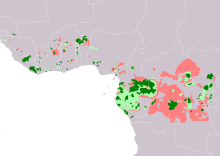African forest elephant
![]()
This article is about the forest elephant living today, for the extinct forest elephant, see European forest elephant.
The forest elephant (Loxodonta cyclotis), sometimes also called African forest elephant, is a species of the genus African elephant (Loxodonta). Its range includes the tropical rainforests of central and western Africa. It is the smaller of the two representatives of the elephant family on the continent. Externally, it largely resembles its larger relative, the African elephant, but has some variations in detail. These include the more rounded ears, the clearly straight tusks and the less dented back. The two species also have many similarities in behaviour. The animals live in social associations consisting of more closely related cows and offspring. The bulls, on the other hand, act as loners. In contrast to the African elephant, however, the herd associations are smaller and less stable. Forest clearings are of great importance, forming important social contact points for different groups of the forest elephant. The diet is largely based on soft plant foods. A large part of the daily workload is spent foraging for food. Breeding occurs year-round, but has a peak during the dry seasons. Offspring usually consist of a calf that is suckled for up to five years.
The first scientific description of the forest elephant was in 1900. For most of the second half of the 20th century, the elephant representative was considered a subspecies of the African elephant. Only various anatomical and molecular genetic studies in the transition to the 21st century led to a discussion of the independent species character of the forest elephant. Problematic here is a more or less wide corridor along the northern distribution boundary where hybridization with the African elephant occurs. At the beginning of the 20th century another small elephant form from central Africa was described and called "dwarf elephant". Here, too, various studies show that the "pygmy elephant" is identical to the forest elephant. The populations have greatly dwindled due to poaching and the destruction of the rainforests; international commercial trade in the animals is prohibited by the agreements in the Washington Convention on International Trade in Endangered Species.
Features
Habitus
The forest elephant is smaller than the African elephant (Loxodonta africana). The shoulder height of males varies from 214 to 290 cm (average 244 cm), with females ranging from 176 to 234 cm (average 198 cm). Studies of animals in the Dzanga Sanctuary in the Central African Republic showed a maximum height of 280 cm. In contrast, animals from Loango National Park in Gabon were significantly smaller with a maximum of 216 cm. Weight is poorly known, but possibly varies between 2 and 4 t. Other authors give around 1.7 t on average.
Externally, the forest elephant resembles its larger African relative, but it is more compactly built and its back line runs rather straight and not so clearly dented. The ears are mostly rounder and smaller than those of the African elephant, although the shape varies from individual to individual. The lower edges of the ears may extend below the chin line. The skin color generally appears gray; however, as a result of mud baths, it often tends to yellowish to reddish brown. Body hair is sparse, exceptions being newborns with a denser black coat. Some females grow a slight beard on the chin. The tail length differs between individuals. For example, the tail may occupy only about half the height of the back, or the tip may touch the ground. It is encased in a thick skin and ends in an asymmetrical, broad tip, which in turn is covered by a tassel of hairs 2 to 20 cm long. The hands and feet are each five-lobed, as in all elephants. In contrast to the African elephant, five nail-like formations occur on the forefoot and four on the hindfoot.
Skull and dentition characteristics
The skull reaches a length of 47 to 63 cm. It is solidly built like that of the African elephant, but appears broader overall both at the skullcap and at the alveoli of the tusks. A striking feature of elephant skulls are the air-filled chambers of the frontal bone, which have a construction reminiscent of honeycombs. In the forest elephant, the chambers are not as distinctly formed as in the African elephant. The lower jaw has a long and low shape. Compared to the African elephant, the symphysis is absolutely and relatively longer with an average length of 18.5 cm. The dentition typically for elephants consists of 26 teeth with the following dental formula: 

Skulls of the African elephant (left) and the forest elephant (right) in comparison
Distribution
The distribution of the forest elephant is poorly studied. In general, it occurs in Central Africa and inhabits the Congo Basin from Equatorial Guinea and Gabon in the west, through the Republic of Congo, southern Cameroon and the Central African Republic, to the east of the Democratic Republic of Congo. In addition, the species is present in West Africa. The boundaries here and in north-central Africa are unknown, as there is a more or less wide corridor of admixture with the Africanelephant, and the two elephant representatives hybridize there to some extent. A common occurrence of these has been documented in the Fazao-Malfakassa National Park in Togo, among other places. The habitat of the forest elephant mainly comprises intact and dense tropical rainforests, but the forest elephant also partly inhabits the transition zones to the savannah areas. Due to the destruction of the rainforests, the distribution area is largely fragmented. In western Africa, the occurrence of the species is limited to about three dozen isolated forest fragments of an average size of 800 km². Generally, the animals use undisturbed forests and avoid areas of intense human activity. They also rarely visit various agricultural areas such as plantations. There is little information available on population density, which is usually determined by counting dung heaps, but also to a lesser extent by counting individuals in territorial patches or by the vocalizations of the animals. For Gabon, the total population may be around 25,000 individuals, for the Democratic Republic of Congo probably as many as 20,000, for Equatorial Guinea estimates are around 1300 animals. During a 20-year survey in the Dzanga Conservation Area of about 6,800 km², more than 3100 animals were observed with a stable annual number of 1660 to 1860 individuals. In Loango National Park in Gabon, the population density is about 2.57 animals per square kilometre. In contrast, two forest fragments in Ghana harboured about 0.04 and 0.64 individuals per square kilometre, respectively. In general, several populations in western Africa are considered to be poorly viable due to their small size and uneven sex and age distribution.

Distribution of the forest elephant: Year round occurrence Probable year-round occurrence Population probably extinct
Questions and Answers
Q: Where do African forest elephants live?
A: African forest elephants live in the forests of the Congo Basin.
Q: Are African forest elephants considered a separate species from African bush elephants?
A: Yes, African forest elephants are often considered a separate species from African bush elephants.
Q: What did a 2010 study say about African forest elephants and African bush elephants?
A: A 2010 study said that African forest elephants and African bush elephants were two different species.
Q: Can African forest elephants and African bush elephants interbreed?
A: Yes, African forest elephants and African bush elephants can interbreed successfully.
Q: If African forest elephants and African bush elephants can interbreed, what does that suggest about their species classification?
A: If African forest elephants and African bush elephants can interbreed, they may only be separate subspecies of Loxodonta africana.
Q: What adaptation do African forest elephants have for living in the rainforest?
A: African forest elephants have a smaller size that is adapted to the rainforest conditions.
Q: What is the scientific name for African forest elephants?
A: The scientific name for African forest elephants is Loxodonta cyclotis.
Search within the encyclopedia